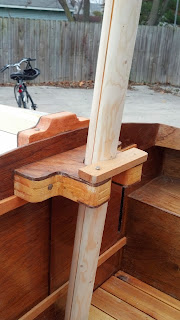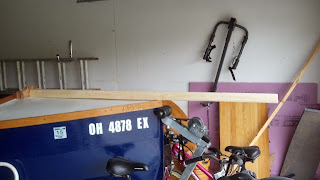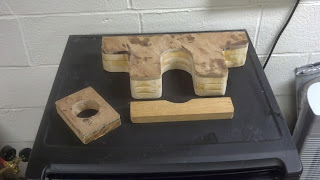Then I worked on the mast step and partner. I drilled two horizontal 1/4 inch (6 mm) bolt holes through the partner and bulkhead, and two vertical holes for the bolts that will keep in place the oak board securing the mast in the partner (second photo). While I was drilling the port side bolt hole the wood cracked. To deal with the crack and to avoid any more problems I removed 1/4 inch thick pieces from the bottom of the partner and glued plywood there: you can see the plywood layer if you look carefully.

I then put the mast step down on the keel batten with bronze nails, epoxy and stainless steel screws, and secured the partner to the main bulkhead with epoxy and two long lag bolts, with washers and nuts on the other side of the bulkhead. Then came the time to try out the mast in its place. As it turns out I had not accounted for the rake of the mast ahead of time (it was hard to do anyway), so the mast could not go all the way in and the oak board going across could not close. I worked on the partner with the wood rasp, testing the fit several times. Like all hand work it took a while, but now the mast fits in its partner and step. Stepping it several times proved to me that it is easily doable by one person.
 The last photo shows the new mast and bowsprit. They still need some hardware and finishing, but I was pleasantly surprised at how straight a mast made from a couple of 2x4s turned out to be. It is a little awkward and definitely heavier than the previous ones (as it needs to be) but at least it does not need to be vertically dropped through a partner hole, something that would probably hurt my back at my age. I can shoulder it and walk it into place pretty easily.
The last photo shows the new mast and bowsprit. They still need some hardware and finishing, but I was pleasantly surprised at how straight a mast made from a couple of 2x4s turned out to be. It is a little awkward and definitely heavier than the previous ones (as it needs to be) but at least it does not need to be vertically dropped through a partner hole, something that would probably hurt my back at my age. I can shoulder it and walk it into place pretty easily.I have already cut and shaped the wooden pad eyes for shrouds, and will be working on sails and standing rigging soon.
Until the next post,
boatbuilder




